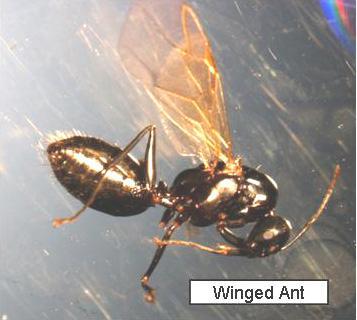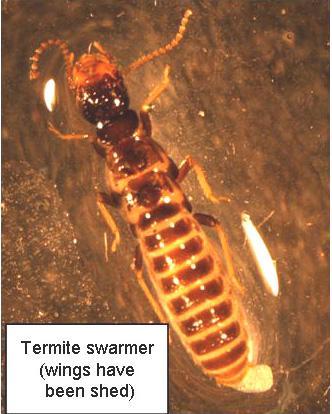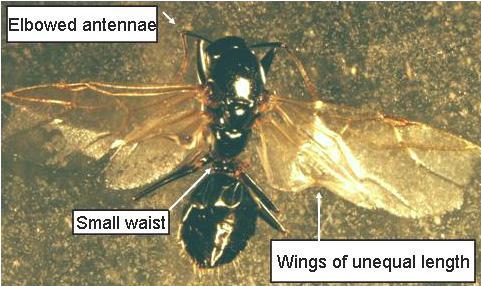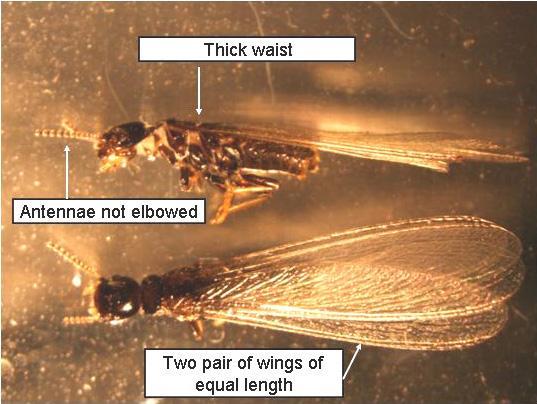Winged Ants and Termites in the House! During spring and summer a large number of winged ant and winged termite samples are received by the Diagnostic Lab. Both termites and ants live in large colonies, and as weather warms up, they are producing winged reproductive males and females to fly to new areas and begin new colonies. It is not uncommon for large numbers of these reproductives to be found in homes, creating quite a nuisance for homeowners. 
 Is it an Ant or a Termite?The first step a homeowner needs to take is to determine if they are dealing with ants or termites. There are three major differences between winged ants and termites.
Is it an Ant or a Termite?The first step a homeowner needs to take is to determine if they are dealing with ants or termites. There are three major differences between winged ants and termites.

Winged Ant Winged Termites (Swarmers) Ants: Hymenoptera Formicidae
Life Cycle: Ants are social insects that live in colonies or nests that can be found in a variety of places, indoor and out. The location of the colony depends on the species of ant. Each colony contains at least one queen ant that is laying eggs and being taken care of by worker ants. Workers are non-reproductive females that have a number of responsibilities including caring for the queen and her brood and foraging for food. During the spring and the summer, most species of ants will produce reproductives. These are winged males and females that leave the colony to mate and find a location to begin a new colony. Usually, the males die after mating and the females disperse, shed their wings and attempt to start a new nest. In many cases, swarming behaviors are synchronized with nearby colonies to maximize mating and reproductive success. Control: The presence of swarming ants can be amazing and may consist of hundreds of winged ants. However, the presence of a swarm from a colony that is established does not mean that infestation levels are going to increase. The winged individuals are going to disperse and leave the colony permanently. If you find a few of these winged ants in your home, the best treatment is to vacuum them up and then throw the vacuum bag into an outdoor trash can. These ants probably wandered in by chance and are not likely to begin a colony inside your home. Finding a significant swarm inside of a home may mean that the colony is located somewhere inside the house or very near your home. In this case, there are several measures that can be taken to reduce indoor ant populations or to get rid of the colony. Sanitation – Many indoor ants subsist on the same food we do. The presence of crumbs, food scraps, dog food, and open food containers are found by foraging ants which then attract large numbers of ants. Removing food sources often reduces or eliminates indoor ant problems. Chemical – Insecticides may reduce indoor populations but is rarely effective in eliminating the colony unless the nest is treated. Only insecticides labeled as ready-for-use indoors should be used. For outdoor colonies, a concentrate used to make your own spray may be more economical. Ants can be controlled by treating trails leading into your home or, if the nest can be located, it can be treated to destroy the colony. In some cases nests may be out of reach and may require the services of a professional pest control operator. For more information on ants, please visit: http://www.bookstore.ksre.ksu.edu/pubs/MF2887.PDF Termites: Isoptera Rhinotermitidae
Life Cycle: In Kansas, the eastern subterranean termite is the most common and damaging. These termites need warm, moist places to survive and therefore are often associated with soil and mud tubes and tunnels that they build with soil, fecal matter and saliva. Termites are social insects that live in colonies that are made up of at least three different castes. The workers are creamy-white, have a soft body, are wingless, eyeless, and are the most numerous members of the colony. Soldiers are recognized by their large brown heads with two large jaws and are soft-bodied like workers. The winged reproductives, often called swarmers, have two pairs of wings that are longer than the length of the body and are all of equal length. They have dark colored bodies, and large eyes. In many cases, it is the swarmers that alert homeowners to the presence of termites. Like ants, these termites are leaving the nest to mate and begin a new colony. Control: The presence of swarmers may indicate that there is an existing termite problem in or around a home, but the swarmers themselves are not dangerous and are not going to be successful at starting a new colony in your home. Unless the females land on moist soil, they will die within a short amount of time. Like ants, once the termites have mated they will start to shed their wings and homeowners may find wingless swarmers or wings lying around in window seals. These insects can be removed from the home by vacuuming them up and placing the vacuum bag in an outdoor trash can. If termite swarmers are found, the home should be inspected for other signs of termites. Common symptoms of termite infestations include tube shelters built between the soil and wooden structures and the presence of mud-filled joints in wood framing, paneling, and trim in finished areas of a structure. In many cases, wood damaged by termites goes undetected. If termite damage is suspected, probe wood near a foundation with an ice pick or similar tool. If the wood is soft and easily punctured, termites are likely to blame. Termite infestations are best treated and controlled by a professional pest control operator. For more information on termites, please visit: http://www.bookstore.ksre.ksu.edu/pubs/MF722.PDF Literature Cited: Brooks, L.H. 1988. Home and Horticultural Pests-Ants. MF-794. Kansas State University Agricultural Experiment Station and Cooperative Extension Service. Cress, D.C. 1999. Home and Horticultural Pests-Termites. MF-722. http://www.bookstore.ksre.ksu.edu/pubs/MF722.PDF Kansas State University Agricultural Experiment Station and Cooperative Extension Service. Drees, B.M., and B. Summerlin. 1997. House infesting ants and their management. L-2061. http://insects.tamu.edu/extension/bulletins/l-2061.html. Texas A&M University Extension Publication. Salsbury, G.A., and S.C. White. 2000. Insects in Kansas. Kansas Department of Agriculture.
Winged Termites (Swarmers) Ants: Hymenoptera Formicidae
Life Cycle: Ants are social insects that live in colonies or nests that can be found in a variety of places, indoor and out. The location of the colony depends on the species of ant. Each colony contains at least one queen ant that is laying eggs and being taken care of by worker ants. Workers are non-reproductive females that have a number of responsibilities including caring for the queen and her brood and foraging for food. During the spring and the summer, most species of ants will produce reproductives. These are winged males and females that leave the colony to mate and find a location to begin a new colony. Usually, the males die after mating and the females disperse, shed their wings and attempt to start a new nest. In many cases, swarming behaviors are synchronized with nearby colonies to maximize mating and reproductive success. Control: The presence of swarming ants can be amazing and may consist of hundreds of winged ants. However, the presence of a swarm from a colony that is established does not mean that infestation levels are going to increase. The winged individuals are going to disperse and leave the colony permanently. If you find a few of these winged ants in your home, the best treatment is to vacuum them up and then throw the vacuum bag into an outdoor trash can. These ants probably wandered in by chance and are not likely to begin a colony inside your home. Finding a significant swarm inside of a home may mean that the colony is located somewhere inside the house or very near your home. In this case, there are several measures that can be taken to reduce indoor ant populations or to get rid of the colony. Sanitation – Many indoor ants subsist on the same food we do. The presence of crumbs, food scraps, dog food, and open food containers are found by foraging ants which then attract large numbers of ants. Removing food sources often reduces or eliminates indoor ant problems. Chemical – Insecticides may reduce indoor populations but is rarely effective in eliminating the colony unless the nest is treated. Only insecticides labeled as ready-for-use indoors should be used. For outdoor colonies, a concentrate used to make your own spray may be more economical. Ants can be controlled by treating trails leading into your home or, if the nest can be located, it can be treated to destroy the colony. In some cases nests may be out of reach and may require the services of a professional pest control operator. For more information on ants, please visit: http://www.bookstore.ksre.ksu.edu/pubs/MF2887.PDF Termites: Isoptera Rhinotermitidae
Life Cycle: In Kansas, the eastern subterranean termite is the most common and damaging. These termites need warm, moist places to survive and therefore are often associated with soil and mud tubes and tunnels that they build with soil, fecal matter and saliva. Termites are social insects that live in colonies that are made up of at least three different castes. The workers are creamy-white, have a soft body, are wingless, eyeless, and are the most numerous members of the colony. Soldiers are recognized by their large brown heads with two large jaws and are soft-bodied like workers. The winged reproductives, often called swarmers, have two pairs of wings that are longer than the length of the body and are all of equal length. They have dark colored bodies, and large eyes. In many cases, it is the swarmers that alert homeowners to the presence of termites. Like ants, these termites are leaving the nest to mate and begin a new colony. Control: The presence of swarmers may indicate that there is an existing termite problem in or around a home, but the swarmers themselves are not dangerous and are not going to be successful at starting a new colony in your home. Unless the females land on moist soil, they will die within a short amount of time. Like ants, once the termites have mated they will start to shed their wings and homeowners may find wingless swarmers or wings lying around in window seals. These insects can be removed from the home by vacuuming them up and placing the vacuum bag in an outdoor trash can. If termite swarmers are found, the home should be inspected for other signs of termites. Common symptoms of termite infestations include tube shelters built between the soil and wooden structures and the presence of mud-filled joints in wood framing, paneling, and trim in finished areas of a structure. In many cases, wood damaged by termites goes undetected. If termite damage is suspected, probe wood near a foundation with an ice pick or similar tool. If the wood is soft and easily punctured, termites are likely to blame. Termite infestations are best treated and controlled by a professional pest control operator. For more information on termites, please visit: http://www.bookstore.ksre.ksu.edu/pubs/MF722.PDF Literature Cited: Brooks, L.H. 1988. Home and Horticultural Pests-Ants. MF-794. Kansas State University Agricultural Experiment Station and Cooperative Extension Service. Cress, D.C. 1999. Home and Horticultural Pests-Termites. MF-722. http://www.bookstore.ksre.ksu.edu/pubs/MF722.PDF Kansas State University Agricultural Experiment Station and Cooperative Extension Service. Drees, B.M., and B. Summerlin. 1997. House infesting ants and their management. L-2061. http://insects.tamu.edu/extension/bulletins/l-2061.html. Texas A&M University Extension Publication. Salsbury, G.A., and S.C. White. 2000. Insects in Kansas. Kansas Department of Agriculture.

 Is it an Ant or a Termite?The first step a homeowner needs to take is to determine if they are dealing with ants or termites. There are three major differences between winged ants and termites.
Is it an Ant or a Termite?The first step a homeowner needs to take is to determine if they are dealing with ants or termites. There are three major differences between winged ants and termites.
| ANTS: | TERMITES: |
| Elbowed antennae | Antennae not elbowed |
| Two pairs of wings of unequal length | Two pairs of wings of equal length |
| Thin waist | Thick waist |

Winged Ant
 Winged Termites (Swarmers) Ants: Hymenoptera Formicidae
Life Cycle: Ants are social insects that live in colonies or nests that can be found in a variety of places, indoor and out. The location of the colony depends on the species of ant. Each colony contains at least one queen ant that is laying eggs and being taken care of by worker ants. Workers are non-reproductive females that have a number of responsibilities including caring for the queen and her brood and foraging for food. During the spring and the summer, most species of ants will produce reproductives. These are winged males and females that leave the colony to mate and find a location to begin a new colony. Usually, the males die after mating and the females disperse, shed their wings and attempt to start a new nest. In many cases, swarming behaviors are synchronized with nearby colonies to maximize mating and reproductive success. Control: The presence of swarming ants can be amazing and may consist of hundreds of winged ants. However, the presence of a swarm from a colony that is established does not mean that infestation levels are going to increase. The winged individuals are going to disperse and leave the colony permanently. If you find a few of these winged ants in your home, the best treatment is to vacuum them up and then throw the vacuum bag into an outdoor trash can. These ants probably wandered in by chance and are not likely to begin a colony inside your home. Finding a significant swarm inside of a home may mean that the colony is located somewhere inside the house or very near your home. In this case, there are several measures that can be taken to reduce indoor ant populations or to get rid of the colony. Sanitation – Many indoor ants subsist on the same food we do. The presence of crumbs, food scraps, dog food, and open food containers are found by foraging ants which then attract large numbers of ants. Removing food sources often reduces or eliminates indoor ant problems. Chemical – Insecticides may reduce indoor populations but is rarely effective in eliminating the colony unless the nest is treated. Only insecticides labeled as ready-for-use indoors should be used. For outdoor colonies, a concentrate used to make your own spray may be more economical. Ants can be controlled by treating trails leading into your home or, if the nest can be located, it can be treated to destroy the colony. In some cases nests may be out of reach and may require the services of a professional pest control operator. For more information on ants, please visit: http://www.bookstore.ksre.ksu.edu/pubs/MF2887.PDF Termites: Isoptera Rhinotermitidae
Life Cycle: In Kansas, the eastern subterranean termite is the most common and damaging. These termites need warm, moist places to survive and therefore are often associated with soil and mud tubes and tunnels that they build with soil, fecal matter and saliva. Termites are social insects that live in colonies that are made up of at least three different castes. The workers are creamy-white, have a soft body, are wingless, eyeless, and are the most numerous members of the colony. Soldiers are recognized by their large brown heads with two large jaws and are soft-bodied like workers. The winged reproductives, often called swarmers, have two pairs of wings that are longer than the length of the body and are all of equal length. They have dark colored bodies, and large eyes. In many cases, it is the swarmers that alert homeowners to the presence of termites. Like ants, these termites are leaving the nest to mate and begin a new colony. Control: The presence of swarmers may indicate that there is an existing termite problem in or around a home, but the swarmers themselves are not dangerous and are not going to be successful at starting a new colony in your home. Unless the females land on moist soil, they will die within a short amount of time. Like ants, once the termites have mated they will start to shed their wings and homeowners may find wingless swarmers or wings lying around in window seals. These insects can be removed from the home by vacuuming them up and placing the vacuum bag in an outdoor trash can. If termite swarmers are found, the home should be inspected for other signs of termites. Common symptoms of termite infestations include tube shelters built between the soil and wooden structures and the presence of mud-filled joints in wood framing, paneling, and trim in finished areas of a structure. In many cases, wood damaged by termites goes undetected. If termite damage is suspected, probe wood near a foundation with an ice pick or similar tool. If the wood is soft and easily punctured, termites are likely to blame. Termite infestations are best treated and controlled by a professional pest control operator. For more information on termites, please visit: http://www.bookstore.ksre.ksu.edu/pubs/MF722.PDF Literature Cited: Brooks, L.H. 1988. Home and Horticultural Pests-Ants. MF-794. Kansas State University Agricultural Experiment Station and Cooperative Extension Service. Cress, D.C. 1999. Home and Horticultural Pests-Termites. MF-722. http://www.bookstore.ksre.ksu.edu/pubs/MF722.PDF Kansas State University Agricultural Experiment Station and Cooperative Extension Service. Drees, B.M., and B. Summerlin. 1997. House infesting ants and their management. L-2061. http://insects.tamu.edu/extension/bulletins/l-2061.html. Texas A&M University Extension Publication. Salsbury, G.A., and S.C. White. 2000. Insects in Kansas. Kansas Department of Agriculture.
Winged Termites (Swarmers) Ants: Hymenoptera Formicidae
Life Cycle: Ants are social insects that live in colonies or nests that can be found in a variety of places, indoor and out. The location of the colony depends on the species of ant. Each colony contains at least one queen ant that is laying eggs and being taken care of by worker ants. Workers are non-reproductive females that have a number of responsibilities including caring for the queen and her brood and foraging for food. During the spring and the summer, most species of ants will produce reproductives. These are winged males and females that leave the colony to mate and find a location to begin a new colony. Usually, the males die after mating and the females disperse, shed their wings and attempt to start a new nest. In many cases, swarming behaviors are synchronized with nearby colonies to maximize mating and reproductive success. Control: The presence of swarming ants can be amazing and may consist of hundreds of winged ants. However, the presence of a swarm from a colony that is established does not mean that infestation levels are going to increase. The winged individuals are going to disperse and leave the colony permanently. If you find a few of these winged ants in your home, the best treatment is to vacuum them up and then throw the vacuum bag into an outdoor trash can. These ants probably wandered in by chance and are not likely to begin a colony inside your home. Finding a significant swarm inside of a home may mean that the colony is located somewhere inside the house or very near your home. In this case, there are several measures that can be taken to reduce indoor ant populations or to get rid of the colony. Sanitation – Many indoor ants subsist on the same food we do. The presence of crumbs, food scraps, dog food, and open food containers are found by foraging ants which then attract large numbers of ants. Removing food sources often reduces or eliminates indoor ant problems. Chemical – Insecticides may reduce indoor populations but is rarely effective in eliminating the colony unless the nest is treated. Only insecticides labeled as ready-for-use indoors should be used. For outdoor colonies, a concentrate used to make your own spray may be more economical. Ants can be controlled by treating trails leading into your home or, if the nest can be located, it can be treated to destroy the colony. In some cases nests may be out of reach and may require the services of a professional pest control operator. For more information on ants, please visit: http://www.bookstore.ksre.ksu.edu/pubs/MF2887.PDF Termites: Isoptera Rhinotermitidae
Life Cycle: In Kansas, the eastern subterranean termite is the most common and damaging. These termites need warm, moist places to survive and therefore are often associated with soil and mud tubes and tunnels that they build with soil, fecal matter and saliva. Termites are social insects that live in colonies that are made up of at least three different castes. The workers are creamy-white, have a soft body, are wingless, eyeless, and are the most numerous members of the colony. Soldiers are recognized by their large brown heads with two large jaws and are soft-bodied like workers. The winged reproductives, often called swarmers, have two pairs of wings that are longer than the length of the body and are all of equal length. They have dark colored bodies, and large eyes. In many cases, it is the swarmers that alert homeowners to the presence of termites. Like ants, these termites are leaving the nest to mate and begin a new colony. Control: The presence of swarmers may indicate that there is an existing termite problem in or around a home, but the swarmers themselves are not dangerous and are not going to be successful at starting a new colony in your home. Unless the females land on moist soil, they will die within a short amount of time. Like ants, once the termites have mated they will start to shed their wings and homeowners may find wingless swarmers or wings lying around in window seals. These insects can be removed from the home by vacuuming them up and placing the vacuum bag in an outdoor trash can. If termite swarmers are found, the home should be inspected for other signs of termites. Common symptoms of termite infestations include tube shelters built between the soil and wooden structures and the presence of mud-filled joints in wood framing, paneling, and trim in finished areas of a structure. In many cases, wood damaged by termites goes undetected. If termite damage is suspected, probe wood near a foundation with an ice pick or similar tool. If the wood is soft and easily punctured, termites are likely to blame. Termite infestations are best treated and controlled by a professional pest control operator. For more information on termites, please visit: http://www.bookstore.ksre.ksu.edu/pubs/MF722.PDF Literature Cited: Brooks, L.H. 1988. Home and Horticultural Pests-Ants. MF-794. Kansas State University Agricultural Experiment Station and Cooperative Extension Service. Cress, D.C. 1999. Home and Horticultural Pests-Termites. MF-722. http://www.bookstore.ksre.ksu.edu/pubs/MF722.PDF Kansas State University Agricultural Experiment Station and Cooperative Extension Service. Drees, B.M., and B. Summerlin. 1997. House infesting ants and their management. L-2061. http://insects.tamu.edu/extension/bulletins/l-2061.html. Texas A&M University Extension Publication. Salsbury, G.A., and S.C. White. 2000. Insects in Kansas. Kansas Department of Agriculture.
May, 2008 -- Holly Davis, Extension Entomology Diagnostician.